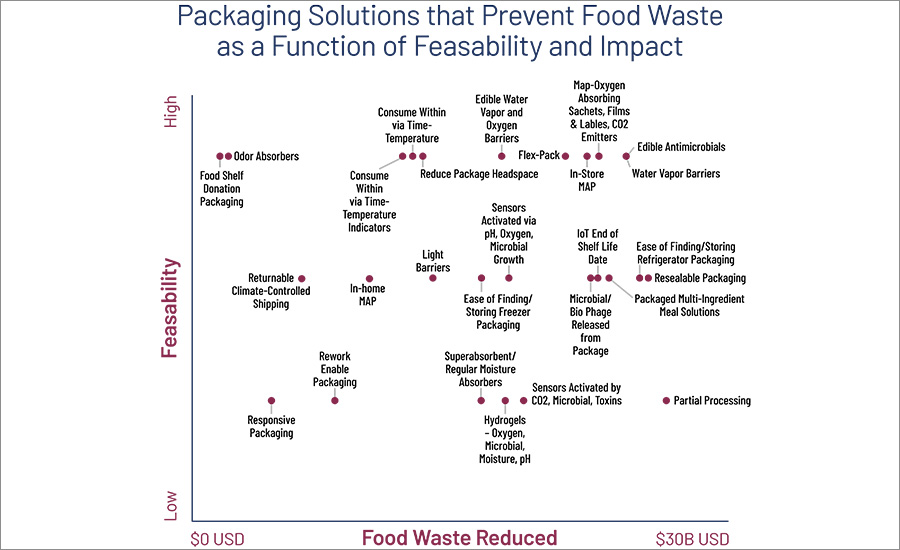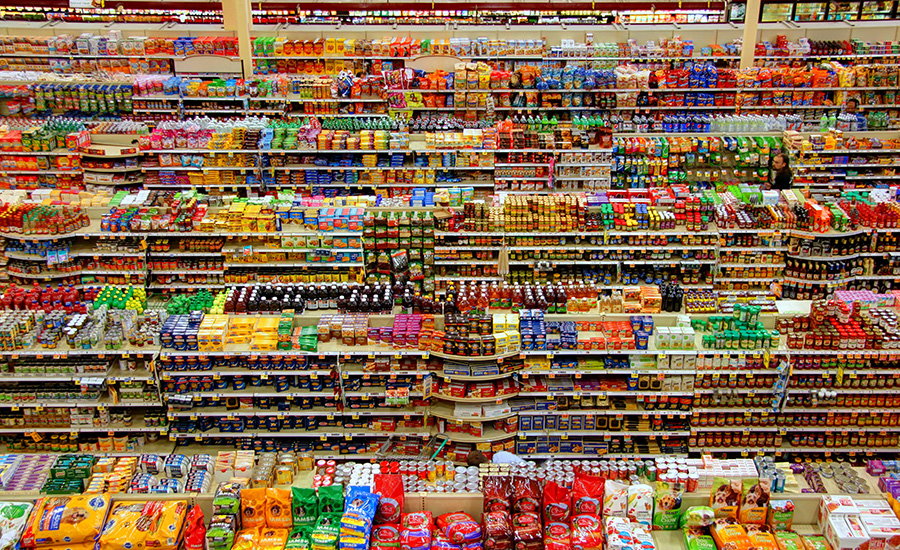As more consumer demands and regulations are placed on consumer packaged goods companies (CPG), food packaging has to extend shelf-life, present new consumer experiences and reduce food waste while at a very low price per unit. Food waste is increasing across the world, and at times, it seems the primary purpose of packaging is getting lost. As the industry wrestles with sustainable film material development, the U.S. wastes 80 billion pounds of food per year.
Flexible Packaging reached out to Claire Sand, owner and CEO at Packaging Technology and Research, to discuss food safety packaging trends and how the circular economy mandates are affecting material development in general. Recently, Claire’s company released a 2021 research paper with Value Chain Management International, titled, “Unwrapping the Arguments: Solving Packaging and Food Waste Through Government and Industry Collaboration.”
The paper states that a “one-size fits all” governmental policy to increase the use of recycled plastics will not reduce greenhouse gas emissions and further complicate the problem. The paper points out that “carbon emissions — in the U.S. and Canada — that result from the food loss and waste (FLW) that is landfilled are greater than plastic food packaging’s environmental footprint; and that packaging typically equates to just approximately 5% of a food’s total carbon footprint.”
With these themes in place, Flexible Packaging dove a bit deeper with Claire Sand; the interview has been lightly edited for clarity.
So what food waste packaging technologies are emerging and what are some areas to explore for further research?
Claire Sand: To consider what technologies can reduce food waste, we need to take a step back and really look at the things we can do with packaging and how we can use flexible packaging to add resiliency and protect food.
One of the technologies is an opportunity for flexible packaging and specifically multi-layer packaging “infinite sink” technology. This technology can transfer many key shelf-life extenders (beyond BHT/BHA), flavors and critical nutrients or ingredients via package layers. For example, when an oxygen-sensitive nutrient is sandwiched between two film layers, it is protected until it migrates or is allowed to release. This enables flexible film layers to do more than they do now.
One of the other super cool technologies is hydrogels to regulate moisture within the package. This can extend the shelf life and allow for a wider array of barriers to be used.
The third technology with broad implications is beta packaging. In packaging, we generally focus on making sure our primary packaging does not change — or is static — once it leaves the production floor. Beta packaging takes a different approach away from this static package approach. Using beta packaging, we allow the packaging to change. The advantage of this capability reaches many areas. Static packaged products made 12 months ago do not connect to rapidly changing consumer trends. For example, elderberry is a popular nutraceutical ingredient now. But it wasn’t 12 months ago. Beta packaging design can introduce this new ingredient — from the actual addition to the label modification. Moving away from static packaging creates a world of opportunity in flexible packaging. Extensive research in both design and material science is needed.
It seems like CPGs are “leaning in” with all types of messaging, such as sustainable sourcing, reduced plastic material and organic materials. So, it seems like food waste would fit into this greenhouse gas and sustainable messaging? What packaging innovations are you seeing out there?
Sand: Yes, that’s right. The link between food and package waste is there. It does need to be more substantial, though. Essentially, more sustainable food packaging is packaging that prevents food waste. The UN Strategic Development Goals (UNSDGs) link food and packaging waste using Target 12.
But, to get consumers to think of packaging as a “food waste preventer” versus as a “waste producer”, we need to address the “waste producer” perception of packaging. The first step in this effort is to collect all post-consumer packaging. The flexible packaging industry has been left out of many collection efforts, so it is no surprise that the consumer perception of its value is low. But, this perception is not reality. If consumers see that flexible packaging has a value, then their thinking can shift to the view that flexible packaging is a “food waste preventer.”

Excerpted from Packaging Technology and Research project sponsored by ReFED 2019.
In terms of innovation, we need more design innovation that separates the barrier required from the structure required. I was just looking at the GF Harvest, a single-serve oatmeal container. The package forms a bowl via two packaging structures — rigid packaging on the outside and a flexible film inside. The flexible film provides the WVTR and hygroscopicity, while the paperboard provides the needed support. Related to this, there is also much potential in separating flexible film layers. What if we consider the benefits of and account for delamination? It seems like blasphemy! But, by controlling delamination, we can maintain barrier properties and integrity and enable easily separable layers that can then be more easily dealt with by post-consumer handlers.
In material science, we’re seeing a lot of switching from fossil-derived polymers to bio-derived polymers such as bio-derived polyethylene, ethylene glycol, PET and terephthalate. These are essentially “drop-in” solutions with much lower environmental impact and also require fewer conversion resources.
Do you think CPGs can communicate a more holistic message to consumers around food waste and packaging as part of the circular economy?
Sand: Yes, in a word. I think as a packaging industry, we need to explain this more tangibly to consumers and brands. We need to acknowledge that like everything (including this interview), packaging too has an environmental impact. But the environmental impact of wasted food is much more significant than packaging. If food waste was a country in terms of GHG emissions, it would rank third. I haven’t seen the statistics on the collective GHG generated from food packaging, but it likely would not be near that.
Brands are working hard to decrease food waste within their internal operations, and much progress has been made. However, targets, such as the 50% food waste reduction by 2030, simply cannot be met unless consumer-derived food waste is addressed. And flexible packaging has a key role here due to the array of barriers, formats and, well, flexibility.
A blend of science, consumer insights is needed to achieve a more sustainable food system. Brands know that packaging can be used more effectively to reduce consumer-derived food waste. But this investment in packaging and food waste reduction needs to translate into increased market share to align with business goals. This is because sales in the entire value chain decline proportionally with less consumer-derived food waste. Basically, flexible packaging technology that focuses on making the most food waste prevention impact and then communicates this effectively to consumers will drive sales.

. Photo by Peter Bond on Unsplash
So in the packaging industry, we are part of the solution. But this requires focus and a shift away from the current “material science wars.” These wars do not help move the dial on reducing GHG emissions, and instead create confusion and missed opportunities. The opportunities missed are very sad. My company works on developing more sustainable packaging strategies and I have seen companies, unfortunately, look at all the data — which is unbiased and our peer-reviewed lifecycle analysis (LCA) —and then make a decision that is more popular with consumers but has a higher environmental impact.
So, while we expend energy on material science wars, brands need packaging that communicates clearly to consumers. A more proactive approach is to help brands explore what packaging can do to prevent food waste and communicate this meaningfully to consumers. There’s a vast opportunity for flexible packaging to focus on food waste prevention — a “we-reduce-food-waste for consumers” type of platform.
There is a danger in not acting more proactively and we see this play out in packaging bans, taxes and lack of proper disposal.
On a positive note. I am highly optimistic because I also see brands — especially private label brands — with a more nuanced perspective. We have retailers now who are really trying to make the right decision on reducing their GHG footprint. Kroger is a good example. While their vast food waste initiative now only extends from “farm-to-floor” retail space, an extension of this initiative to the consumer’s “fridge-to-fork” is viable. Kroger and other private label brands are on the cusp of food waste prevention from “fridge to fork” consumer positioning. And each layer of flexible packaging can make a real environmental impact in preventing food waste.
Claire Koelsch Sand is owner and CEO at Packaging Technology and Research.
